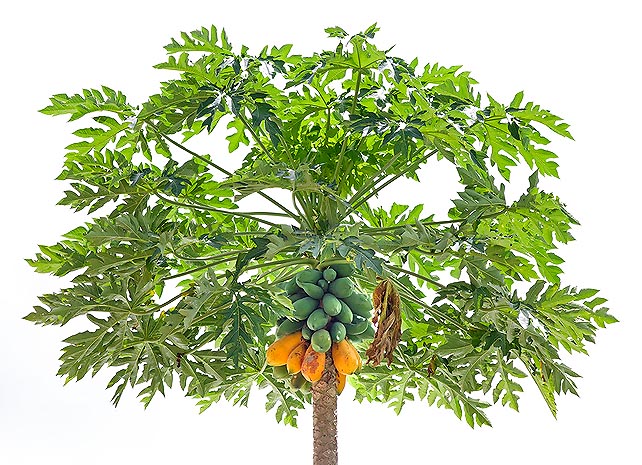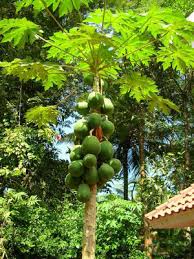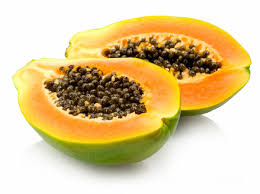Carica papaya Linn
| Botanical Name | Carica papaya Linn |
| Order: | Brassicales |
| Family: | Caricaceae |
| Genus: | Carica |
| Species: | C. papaya |
| Common Names: | English Name: Pawpaw |
Plant Synonyms
Plant Local Names
Hausa Name: Gwanda
Igbo Name: Ogede Oyinbo
Yoruba Name: Ibepe
Plant Habitat
Native of tropical America, widespread in warm countries
Plant Material of Interest
Leaves, latex, fruit
Plant Description
Tree is up to 500cm or sometimes higher. Short-lived, unbranched, a little branched, soft stemmed. Stems are hollow and all parts of the plant exude a thick milky sap.
Leaves are large and dissected on long stalk, spirally arranged, laterally caudices leaving large conspicuous scars on the trunk.
Flowers the male and female flowers are borne on separate plants but rarely, some are bisexual. The female flowers are solitary or very few together in the axils of the leaves; they are larger while the male flowers are produced on long stalks. They are fragrant.
The fruits are in different varieties, varying in size and shape from ovoid or pear-shaped. The flesh of the fruit is yellow or orange and seeds have a pulpy coat (Seaforth et. al., 1983)
Plant Used Parts
Plant Uses
i. Macerated dry leaves used to treat gonorrhea
ii. Leaves as ingredient in a concoction used as remedy for AIDS
iii. Leaves as ingredient of preparation used as fever remedy
iv. Leaves used as ingredient in remedy for hernia and appendicitis
v. Leaves used as ingredient of concoction uses as remedy for measles
vi. As amoebicide (Kokwaro, 1993)
Plant Therapeutic Action
Plant Precaution for Use
Plant Adverse Effect
Plant Contraindication
Plant Dosage Forms
Plant Dosage
Plant Storage
Plant Chromatographic Fingerprint
Plant Constituents
Per 100g, the fruit (green; ripe) contains; calories (26;45), water (92.1g; 87.1g), proteins (1.0g; 0.5g), fat (0.1g; 0.1g), total carbohydrate (6.2g; 11.8g), fibre (0.9g; 0.5g), ash (0.5g; 2.2g), Ca (38mg; 24mg), P (20mg; 22mg), Fe (0.3mg; 0.7mg), Na (7mg; 4mg), K (215mg; 221mg), β-carotene equivalent (15mcg; 710mcg), thiamine (0.02mg; 0.03mg), riboflavin (0.03mg; 0.05mg), niacin (0.3mg; 0.4mg) and ascorbic acid (40mg; 73mg), while the leaves contain 74 calories, 77.5 water, 11.3g total carbohydrate, 1.8 fiber, 2.2g ash, 344mg Ca, 142mg P, 0.8mg Fe, 16mg Na, 652mg K, 11.565mcg β-carotene equivalent, 0.09mg thiamine, 0.48mg riboflavin, 2.1mg niacin, 36mg vitamin E and 140mg ascorbic acid. The seed on the other hand contains 24.3g protein, 25.2g fatty oil, 15.5g total carbohydrate, 17.0g crude fibre and 8.8g ash (Duke, 1985)
The fruit contains methylbutanoate, linalool and its oxide, a-linoleic acid, nicotine, a-phellandrene, a-terpinene, 4-terpineol and terpinolene. The fruit pulp contains butanoic acid, papain, malic acid, salts of tartaric acid and citric acid. The leaf is refuted to contain carpaine, alkaloids, dehydrocarpaine, flavonols, benzylglucosinolate and tannins, while the latex contains chymopapain A and B, papain and benzylglucosinolate. The seed yields benzylisothiocanate, sinigrin, myrosin, carpasemine and carpaine (Duke, 1985). A new phytoalexin (Danielone) has been isolated from the fruit (Evans, 1989).
Plant References
"Carica papaya L". U.S. National Plant Germplasm System. 9 May 2011. Retrieved 5 September 2017.
"Papaw". Collins Dictionary. n.d. Retrieved 2014-09-25.
In North America, papaw or pawpaw usually means the plant belonging to the Annonaceae family or its fruit. Ref.: Merriam-Webster's Collegiate Dictionary (2009), published in United States.
"Carica". 2013.
Morton JF (1987). "Papaya". NewCROP, the New Crop Resource Online Program, Center for New Crops & Plant Products, Purdue University; from p. 336–346. In: Fruits of warm climates, JF Morton, Miami, FL. Retrieved 23 May 2015.
Heywood, VH; Brummitt, RK; Culham, A; Seberg, O (2007). Flowering plant families of the world. Firefly Books. ISBN 9781554072064.
Ronse De Craene, L.P. (2010). Floral diagrams: an aid to understanding flower morphology and evolution. Cambridge: Cambridge University Press. ISBN 978-0-521-49346-8.
"Papayas" (PDF). University of California at Davis. 2016. Retrieved 10 September 2017.



